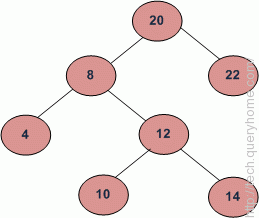This is quite simple. Just traverse the node from root to left recursively until left is NULL. The node whose left is NULL is the node with minimum value.

For the above tree, we start with 20, then we move left 8, we keep on moving to left until we see NULL. Since left of 4 is NULL, 4 is the node with minimum value.
#include <stdio.h>
#include<stdlib.h>
/* A binary tree node has data, pointer to left child
and a pointer to right child */
struct node
{
int data;
struct node* left;
struct node* right;
};
/* Helper function that allocates a new node
with the given data and NULL left and right
pointers. */
struct node* newNode(int data)
{
struct node* node = (struct node*)
malloc(sizeof(struct node));
node->data = data;
node->left = NULL;
node->right = NULL;
return(node);
}
/* Give a binary search tree and a number,
inserts a new node with the given number in
the correct place in the tree. Returns the new
root pointer which the caller should then use
(the standard trick to avoid using reference
parameters). */
struct node* insert(struct node* node, int data)
{
/* 1. If the tree is empty, return a new,
single node */
if (node == NULL)
return(newNode(data));
else
{
/* 2. Otherwise, recur down the tree */
if (data <= node->data)
node->left = insert(node->left, data);
else
node->right = insert(node->right, data);
/* return the (unchanged) node pointer */
return node;
}
}
/* Given a non-empty binary search tree,
return the minimum data value found in that
tree. Note that the entire tree does not need
to be searched. */
int minValue(struct node* node) {
struct node* current = node;
/* loop down to find the leftmost leaf */
while (current->left != NULL) {
current = current->left;
}
return(current->data);
}
/* Driver program to test sameTree function*/
int main()
{
struct node* root = NULL;
root = insert(root, 4);
insert(root, 2);
insert(root, 1);
insert(root, 3);
insert(root, 6);
insert(root, 5);
printf("\n Minimum value in BST is %d", minValue(root));
getchar();
return 0;
}
